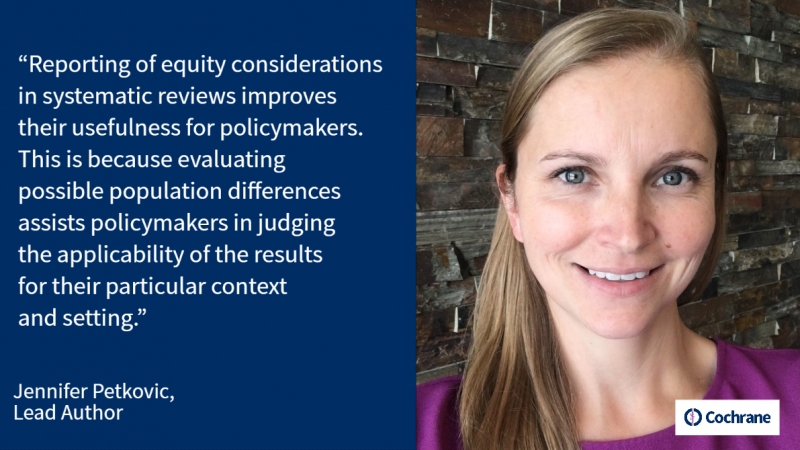
A new module in the Cochrane Interactive Learning online course teaches users about health equity, and how considerations of health equity can be incorporated into the systematic reviews. In this interview, the lead author of this module, Jennifer Petkovic, tell us about the module.
First, can you tell us what health equity means?
Health equity means the absence of avoidable differences in health outcomes. The Cochrane Equity Methods Group uses the mnemonic PROGRESS-Plus to help think about population characteristics which may contribute to health inequities: Place of residence, Race/ethnicity/culture/language, Occupation, Gender/sex, Religion, Education, Socioeconomic status, Social capital, and additional characteristics, such as age, or features of relationships.
Why is health equity important to consider when authoring a systematic review?
Generally, systematic reviews present the average effects of the intervention for the whole population. However, this doesn’t tell us the whole story about its effectiveness. Certain population groups may experience differences related to their baseline risk of the condition or problem being studied or may experience the intervention differently. For users of systematic reviews, such as policymakers, understanding these differences is important for making decisions about whether to implement these interventions. For example, some interventions may seem to have a small relative effect size, but for certain groups within the population, there could actually be a large absolute difference in effect.
Tell us about the module…
We have developed this module to accompany the new Cochrane Handbook for Systematic Reviews of Interventions chapter on Health Equity. The module describes health equity concepts, why and when to consider health equity, and how to consider health equity within the various stages of the systematic review. These include question formulation, searching/extracting/synthesizing evidence, Summary of Findings tables, and assessing applicability of the evidence. We have tried to provide examples of reviews that have considered health equity throughout the module.
How should authors incorporate health equity into their systematic reviews?
We do not expect systematic review authors to assess all population groups or PROGRESS-Plus characteristics within their review. However, we do suggest that all authors think about their population at the protocol stage. To start, authors should think about their intervention and the population under study and consider whether there may be differences in the effectiveness of the intervention for some population groups. Perhaps there are differences in baseline risk or in the acceptability or feasibility of the intervention across populations included in the primary studies that will be included in the review.
Authors can consider health equity at the question formulation stage, possibly using a logic model. Authors should decide on the methods that can be used to identify and appraise evidence related to health equity and specific populations. Authors can think about their ‘Summary of findings’ tables and whether, for example, separate tables or separate rows would be useful for presenting evidence for disadvantaged populations. Finally, authors can interpret the applicability of the findings for other contexts and settings within the discussion.

How is health equity already being incorporated into systematic reviews in Cochrane and elsewhere?
Equity is increasingly being considered in Cochrane and other systematic reviews. There are now 32 Cochrane reviews with the term ‘equity’ in the title and/or abstract. The PRISMA-Equity extension, which is a reporting guideline for equity-focused systematic reviews, has been cited over 200 times since it was published in 2012.
Recently, there have been a few reviews with a major equity focus. For example, the review Interventions for promoting reintegration and reducing harmful behaviour and lifestyles in street‐connected children and young people aimed to assess whether there were population-related differences in effectiveness of the interventions and to extrapolate the findings to low- and middle-income settings. This review noted that there was inconsistent reporting of equity considerations within the included studies. However, the review authors included a section in the discussion to describe the applicability of the findings for low- and middle-income contexts. For example, the review considers differences between low- and middle-income country settings and how this may affect reasons for being on the streets.
Another example is a review which has presented separate Summary of Findings (SOF) tables based on baseline risk of the condition. The review Vaccines for preventing rotavirus diarrhoea: vaccines in use presents the results for low-mortality and high-mortality countries separately, including using separate SOF tables, because vaccine efficacy profiles are different depending on mortality rates.
How could consideration of health equity in evidence synthesis help policymakers?
A previous study suggested that policymakers found that a lack of equity considerations in systematic reviews limited their usefulness for policymaking. Reporting of equity considerations in systematic reviews improves their usefulness for policymakers. This is because evaluating possible population differences assists policymakers in judging the applicability of the results for their particular context and setting.

